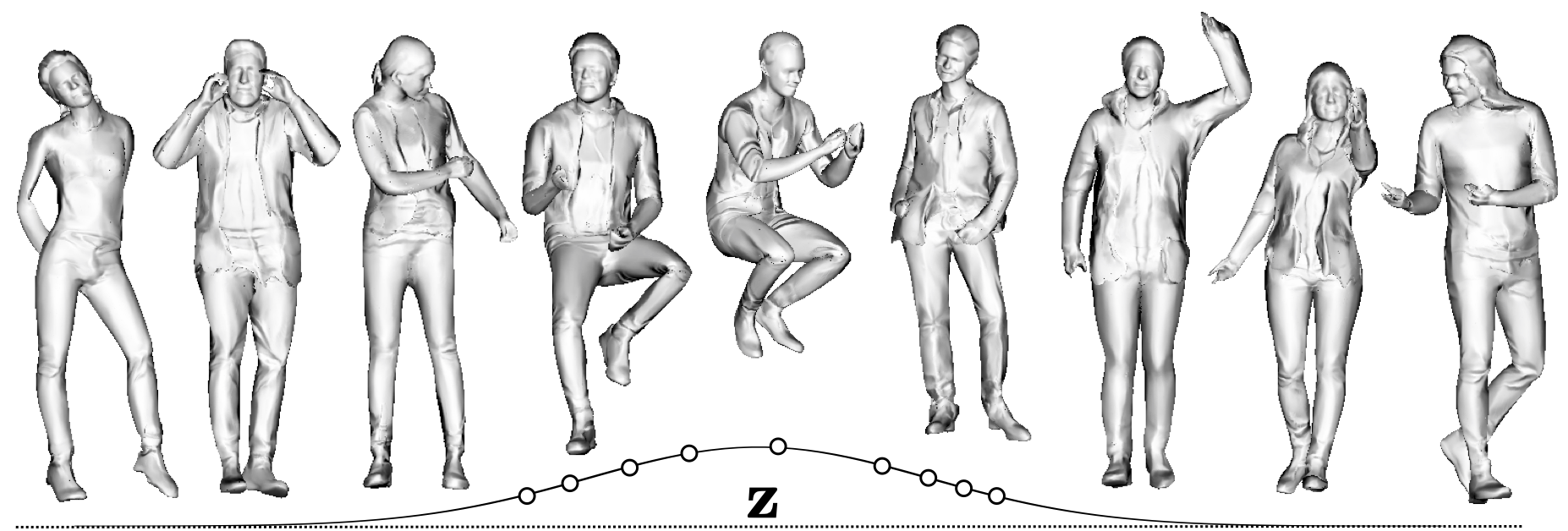Paper | Video | Project Page
Official code release for CVPR 2022 paper gDNA: Towards Generative Detailed Neural Avatars. We propose a model that can generate diverse detailed and animatable 3D humans.
If you find our code or paper useful, please cite as
@inproceedings{chen2022gdna,
title={gDNA: Towards Generative Detailed Neural Avatars},
author={Chen, Xu and Jiang, Tianjian and Song, Jie and Yang, Jinlong and Black, Michael J and Geiger, Andreas and Hilliges, Otmar},
booktitle = {IEEE Conf. on Computer Vision and Pattern Recognition (CVPR)},
year = {2022}
}
Note: In the paper we trained our model with two commercial datasets, 3DPeople and RenderPeople. We haven't yet gotten permission to release a generative model trained with 3DPeople. Instead, we release a model trained with RenderPeople only, and also a model trained with a freely accessible dataset THuman2.0. In addition, the list of original training scans from 3DPeople and RenderPeople can be found in lib/dataset/renderpeople_3dpeople.csv in case one wants to buy them.
Clone this repo:
git clone https://github.com/xuchen-ethz/gdna.git
cd gdna
Install environment:
conda env create -f env.yml
conda activate gdna
python setup.py install
Download SMPL models (1.0.0 for Python 2.7 (10 shape PCs)) and move them to the corresponding locations:
mkdir lib/smpl/smpl_model/
mv /path/to/smpl/models/basicModel_f_lbs_10_207_0_v1.0.0.pkl lib/smpl/smpl_model/SMPL_NEUTRAL.pkl
Download our pretrained models and test motion sequences:
sh ./download_data.sh
Run one of the following command and check the result video in outputs/renderpeople/video
"Dancinterpolation": generate a dancing + interpolation sequence
python test.py expname=renderpeople +experiments=fine eval_mode=interp
Disentangled Control: change the coarse shape while keeping other factors fixed
python test.py expname=renderpeople +experiments=fine eval_mode=z_shape
To control other factors, simply change eval_mode=[z_shape|z_detail|betas|thetas].
Random Sampling: generate samples with random poses and latent codes
python test.py expname=renderpeople +experiments=fine eval_mode=sample
THuman2.0 Model: run the following command with desired eval_mode for the model trained with THuman2.0
python test.py expname=thuman model.norm_network.multires=6 +experiments=fine datamodule=thuman eval_mode=interp
Note that for this dataset we use more frequency components for the positional encoding (model.norm_network.multires=6) due to the rich details in this dataset. Also note that this THuman2.0 model exhibits less body shape (betas) variations bounded by the body shape variations in the training set.
We use THuman2.0 as an example because it's free. The same pipeline works also for commericial datasets, like 3DPeople and RenderPeople which is used to train our orignal model.
Install kaolin for fast occupancy query from meshes.
git clone https://github.com/NVIDIAGameWorks/kaolin
cd kaolin
git checkout v0.9.0
python setup.py develop
First, download THuman2.0 dataset following their instructions.
Also download the corresponding SMPL parameters:
wget https://dataset.ait.ethz.ch/downloads/gdna/THuman2.0_smpl.zip
unzip THuman2.0_smpl.zip -d data/
Next, run the pre-processing script to get ground truth occupancy, surface normal and 2D normal maps:
python preprocess.py --tot 1 --id 0
You can run multiple instantces of the script in parallel by simply specifying --tot to be the number of total instances and --id to be the rank of current instance.
Our model is trained in two stages. First, train the coarse model
python train.py expname=coarse datamodule=thuman
This step takes around 12 hours on 4 Quadro RTX 6000 GPUs.
After the first stage finishes, run the following command to precompute 2D-3D correspondences using implicit renderer+ forward skinning
python precompute.py expname=coarse datamodule=thuman agent_tot=1 agent_id=0
This step is optional but highly recommanded because computing 2D-3D correspondences on the fly is very slow. You can run multiple instantces of the script in parallel by simply specifying agent_tot to be the number of total instances and agent_id to be the rank of current instance.
Next, train the fine model
python train.py expname=fine datamodule=thuman +experiments=fine model.norm_network.multires=6
This step takes around 1.5 days on 4 Quadro RTX 6000 GPUs.
Note that for THuman2.0 we recommand more frequency components for the positional encoding (model.norm_network.multires=6) due to the rich details in this dataset but this is optional.
Training logs are available on wandb (registration needed, free of charge).
Run one of the following command. Note that model.norm_network.multires=6 needs to be modified to be consistent with the training of the fine model.
"Dancinterpolation": generate a dancing + interpolation sequence
python test.py expname=fine +experiments=fine datamodule=thuman eval_mode=interp model.norm_network.multires=6
Disentangled Control: change the coarse shape while keeping other factors fixed
python test.py expname=fine +experiments=fine datamodule=thuman eval_mode=z_shape model.norm_network.multires=6
To control other factors, simply change `eval_mode=[z_shape|z_detail|betas|thetas].
Random Sampling: generate samples with random poses and latent codes
python test.py expname=fine +experiments=fine datamodule=thuman eval_mode=sample model.norm_network.multires=6
The output videos are stored in outputs/fine/video.
Here are some other works on neural implicit avatars from our group :)
-
Chen et. al. - SNARF: Differentiable Forward Skinning for Animating Non-rigid Neural Implicit Shapes
-
Zheng et. al. - I M Avatar: Implicit Morphable Head Avatars from Videos
We have used codes from other great research work, including IGR, IDR, NASA, DEQ, StyleGAN-Ada, Occupancy Networks, SMPL-X, ML-GSN. We sincerely thank the authors for their awesome work!
